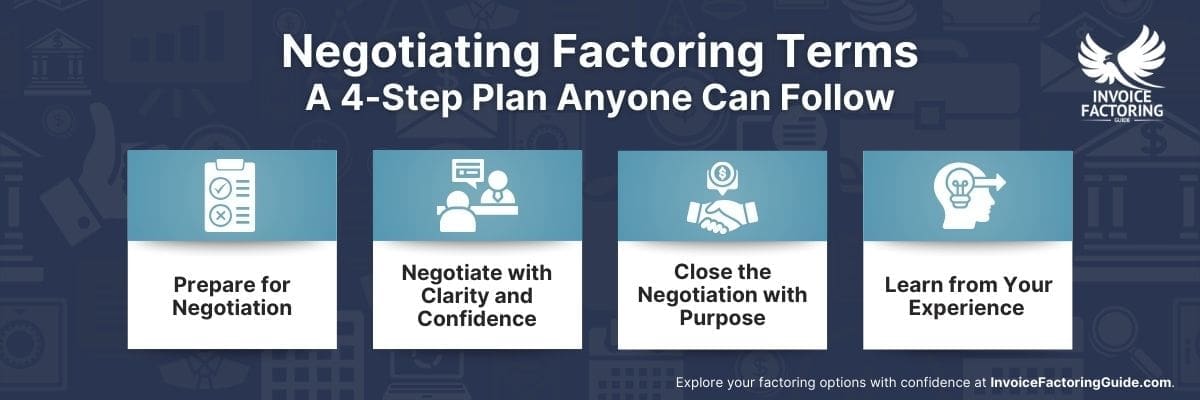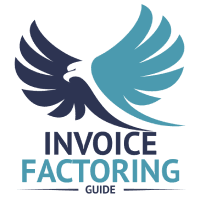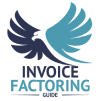
Eight in ten businesses do not have formal negotiation processes, Procurement Tactics reports. While that may not sound like a huge deal, it’s directly tied to your company’s profitability, particularly when it comes to financial concerns. And while negotiating factoring terms can seem intimidating, the reality is that factoring companies have come to expect some pushback, and working to secure a good deal helps you and your future factoring partner in the long run. In this guide, we’ll walk you through areas you can likely negotiate in your factoring agreement and how to approach negotiations to ensure your agreement feels tailor-fit for your business.

Step 1: Prepare for Negotiation
Strong negotiation starts well before you speak with a factoring company. If you understand your position clearly and know which terms are worth pushing on, you’ll have a much better chance of walking away with favorable terms. The steps below will help you go in prepared and avoid being caught off guard.
Identify Terms That May Be Negotiable in Your Factoring Agreement
While some parts of your factoring agreement will be standard, many terms can be adjusted based on your risk profile, industry and credit impact, and invoice volume. Let’s cover some of the most commonly negotiated terms.
- Factoring Fees: Often called the discount rate, this is the percentage the factoring company keeps. Some companies will go lower if your invoices are large, consistent, or from highly creditworthy clients, since creditworthiness affects factoring terms.
- Advance Rate: The percentage of the invoice you get up front. If your customers pay reliably, you may be able to secure a higher advance.
- Reserve Release Timing: Some companies hold the factoring reserve longer than necessary. Others may be willing to shorten the delay after payment is received.
- Contract Length and Cancellation Clauses: Watch for auto-renewal terms or steep termination fees. These are often negotiable if flagged early.
- Monthly Minimums: If your revenue varies, a rigid minimum could cost you. Some factors will adjust it or waive it for seasonal businesses.
- Service and Processing Fees: These often aren’t mentioned in the headline rate but can be negotiated down or eliminated, reducing hidden fees.
Before you sign, request a sample agreement or term sheet. Look for anything that might create friction for your business long-term, not just the upfront numbers.
Know Your Zone of Possible Agreement
The zone of possible agreement (ZOPA) is the range where both you and the factoring company could reasonably agree. Think of it as the overlap between what you’re willing to accept and what they’re willing to offer.
Let’s say you’re comfortable paying up to a 2.8 percent fee, and the factor is willing to go as low as 2.5 percent. There’s room to reach a deal.
But if the lowest they’ll go is 3.5 percent, and that cuts into your margin too deeply, there’s no agreement to be made unless one side adjusts. Understanding your ZOPA helps you know where to focus your energy and when to stop pushing.
Have a Best Alternative to a Negotiated Agreement in Mind
Your best alternative to a negotiated agreement (BATNA) is your backup plan. If the agreement falls through, what is your next step?
A few BATNAs in factoring negotiations are covered below.
- Working with Another Factoring Company: Comparing multiple offers gives you leverage and helps you find the best fit for your goals.
- Using a Business Line of Credit: If you qualify, a line of credit may offer more flexibility and lower cost in the long run.
- Delaying Growth and Self-Financing: Slowing your growth may not be ideal, but it could give you time to secure a better agreement.
- Requesting Faster Customer Payment Terms: If your top clients are open to shorter payment timelines or customizing payment terms based on cash flow, you may be able to manage without factoring.
Knowing your best alternative makes it easier to avoid agreeing to terms that do not support your financial health.
Establish a Walkaway Point
Your walkaway point is the threshold where the deal no longer makes sense for your business. This should be based on your financial model, not emotion or pressure to sign. Your walkaway point might involve one or more of the situations outlined below.
- Unfavorable Factoring Rates: If the fees reduce your profit margins beyond a sustainable point.
- Delayed Reserve Release: If the reserve is held so long that it creates cash flow problems.
- Long-Term Contracts without Flexibility: If the agreement locks you into a structure that could limit your growth, and avoiding long contracts may be a better fit.
Once you identify this line, you can negotiate with more clarity and confidence.
Determine a Stretch Goal
A stretch goal is your ideal outcome. It represents the best version of the deal that still feels realistic based on your business’s strengths. Let’s take a quick look at some stretch goals you might use.
- Lower Factoring Fees: This might be achievable if your customers have strong credit histories and low default risk.
- Higher Advance Rates: You may be able to secure a larger upfront payment if your invoices are consistent and paid on time.
- Faster Reserve Release: A shorter delay in receiving your remaining funds can improve cash flow and reduce uncertainty.
- More Flexible Exit Terms: Consider adding exit clauses to the agreement that make it easier for you to leave. Negotiating exit clauses in factoring can also include things like shorter agreements or reduced termination fees to protect your long-term interests.
Setting a stretch goal early allows you to negotiate without backing yourself into a corner.
Step 2: Negotiate with Clarity and Confidence

Once you’re prepared, it’s time to start the conversation. This step is about presenting your position, asking for what your business needs, and shaping the agreement into something that supports your goals. Negotiation should feel collaborative, not adversarial. A few practical ways to approach the bargaining process are outlined below.
Open with a Professional but Assertive Tone
The tone you set early on matters. Many factoring companies are open to negotiation, but only if you signal that you’re informed, serious, and respectful. Let’s take a look at some ways to start strong.
- State Your Interest Clearly: Let the company know you’re interested in a partnership and have reviewed their offer carefully.
- Acknowledge What You Like: If certain terms already work for your business, mention them. It builds goodwill and narrows the scope of the negotiation.
- Indicate Areas for Discussion: Calmly outline the parts of the agreement you’d like to revisit. For example: “I appreciate the quick reserve release timeline and the transparency around fees. I’d like to talk through the advance rate and the monthly minimum before we move forward.” This approach avoids confrontation and keeps the discussion constructive.
Lead with the Most Important Terms First
You do not need to push back on everything. Focus on the terms that have the greatest financial or operational impact on your business. High-priority areas typically include:
- Factoring Fees: If the rate is too high, explain how it affects your margins, and consider using offers to negotiate factoring rates if appropriate.
- Advance Rate: If you need a higher percentage upfront to manage cash flow, consider negotiating advance rates as part of your initial ask.
- Contract Flexibility: If you expect your needs to change over time, ask for a shorter initial term as part of negotiating flexible factoring contracts.
Make your case using specifics. Show how securing better factoring rates or obtaining improved terms in other areas would allow you to factor more invoices, take on more customers, or improve your ability to grow.
Justify Your Position with Facts
Factoring companies evaluate risk, predictability, and return. If you can demonstrate that your business reduces their risk, you will have more leverage. Consider including:
- Customer Payment History: If your clients consistently pay on time, highlight that.
- Invoice Volume: If you issue a high or growing invoice volume, use invoice volume in negotiations and show the data.
- Industry Predictability: Some industries carry lower risks than others. If you operate in one, use that to your advantage.
- Creditworthiness of Clients: If your customers are large, stable companies with strong credit, that improves your position.
Framing your ask with supporting information shows that you’ve done your homework and that the partnership would benefit both sides.
Ask Questions to Create Movement
If a term seems fixed, don’t accept it at face value. Ask why it’s structured that way or whether there is room for an exception. Some examples include:
- “Is the advance rate capped for all clients, or does it depend on volume?”
- “Would this reserve release timeline shift if our invoices are paid in under 20 days?”
- “What does your typical client profile look like? I’m wondering how our history compares.”
Questions like these invite dialogue and help uncover areas of flexibility. They also position you as someone who understands how these agreements work.
Stay Focused and Avoid Unnecessary Concessions
It is easy to get sidetracked by less important details. Keep your goals in mind and avoid trading away key terms for items that do not meaningfully help your business. Some tips for staying on track are covered below.
- Stick to Priorities: If a term does not impact cash flow, risk, or flexibility, it may not be worth pressing.
- Avoid Unplanned Trade-Offs: Do not offer to give something up unless it gets you closer to a goal you identified during preparation.
- Take Time If Needed: If new terms are introduced during the discussion, pause and ask to review them before responding.
Being confident in your position does not mean rushing the process. It means making thoughtful choices based on your business needs.
Step 3: Close the Negotiation with Purpose
Once the conversation has run its course, it is time to either finalize the agreement or step away. A clear, intentional close ensures that nothing is left to interpretation and helps protect your business, regardless of the outcome.
Confirm the Agreement in Writing
If you have reached an agreement, the next step is to lock in the details. Do not assume anything will be captured correctly unless it is written out clearly. Before you sign:
- Request a Revised Term Sheet or Contract: Ask the factoring company to update the documentation to reflect everything you discussed.
- Review the Terms Carefully: It may be tempting to skim the contract, especially if you feel good about the conversation. In fact, nearly two-thirds of small business owners admit to signing without knowing all the details, according to Adobe. But, this is something you can’t afford to do when your cash flow is on the line. Look for any changes, additions, or omissions. Make sure the final version aligns with your understanding.
- Involve a Legal or Financial Advisor: If possible, have someone else review the agreement before you commit. Even small differences in phrasing can have long-term effects.
Do not feel pressured to sign on the spot. Taking time to review the final paperwork is a standard and responsible step.
Prepare for the Possibility of No Deal
Not every negotiation ends with an agreement. If the final offer does not meet your walkaway criteria, or if the company cannot adjust its terms, it may be time to move on. A few signs that it may be time to walk are covered below.
- Inflexible Terms That Harm Cash Flow: If reserve release timing or advance rates create more strain than benefit.
- Hidden Fees or Confusing Structures: If the agreement lacks transparency or introduces financial uncertainty.
- Aggressive Customer Contact Policies: If the factor’s collection approach risks damaging your client relationships.
Walking away is not a failure. It is a sign that you are committed to protecting your business and confident in your alternatives.
End the Conversation on a Professional Note

Even if you do not move forward, it is worth leaving the door open. To close the conversation:
- Thank the Company for Their Time: A professional exit shows respect and leaves a positive impression.
- Let Them Know Your Reasoning: If appropriate, share why the agreement did not work for you. This may lead to future adjustments.
- Stay Open to Future Conversations: Circumstances change. If your volume grows or your business profile shifts, the terms may become more favorable.
Many businesses revisit factoring options later. Leaving on good terms makes that easier.
Step 4: Learn from Your Experience and Refine Your Approach
Every negotiation gives you insight. Whether you walked away with better terms or chose not to move forward, you now have real data to work with. Taking time to reflect helps you negotiate more effectively next time and build a more strategic approach to financing overall.
Identify What Worked and Why
Look back at the conversation and pinpoint what helped you make progress. Consider:
- Which Terms Were Flexible: Knowing where the company was open to negotiation helps you focus your efforts in the future.
- Which Arguments Were Most Persuasive: If data about your customers’ creditworthiness or invoice volume helped your case, keep that in your toolkit.
- Which Questions Uncovered Leverage: Take note of any specific phrasing or questions that shifted the tone of the conversation.
This review will help you refine your preparation process and enter future negotiations with more clarity.
Take Note of What Created Friction
Understanding what slowed the conversation or blocked agreement is just as important. Ask yourself:
- Where Did the Negotiation Stall: Were there points where communication broke down or trust was lost?
- What Feedback Did You Receive: Did the factoring company express specific concerns about risk, documentation, or business model?
- Were There Surprises in the Contract: If unexpected terms came up late in the process, that is something to flag for next time.
These insights can help you adjust how you present your business, what information you provide early, or which providers you choose to work with.
Track Market Shifts and Industry Norms
Factoring terms are influenced by changes in risk tolerance, interest rates, and economic conditions. What was negotiable six months ago may not be today or vice versa. Let’s take a look at some ways to stay informed.
- Monitor Offers from Other Providers: Even if you are not actively seeking new agreements, reviewing market terms keeps you aware of your options.
- Talk with Other Business Owners: Peer conversations often reveal what factoring companies are offering in similar industries or situations.
- Watch for Changes in Customer Payment Trends: If your clients begin paying faster or slower, that can affect your negotiating position.
Staying plugged into the broader market helps you stay proactive rather than reactive.
Strengthen Your Position for the Future
Use what you learned to improve the way your business approaches financing.
- Build a Record of Customer Payment Behavior: The more you can demonstrate consistent, on-time payments, the stronger your negotiating leverage becomes.
- Diversify Financing Relationships: Even if you are not factoring today, building relationships with multiple providers gives you options later.
- Refine Your Internal Processes: Clean invoicing, clear documentation, and fast dispute resolution all help position you as a lower-risk client and may help build loyalty in factoring over time.
Each negotiation is a learning opportunity. When you treat it that way, you gain more than just terms, you build lasting skill.
Explore Your Options with Confidence
If you’re considering factoring or simply want a better sense of what terms might be available, we can help you take the next step. To find the right fit for your business, request a complimentary rate quote.
FAQs on Negotiating Factoring Terms
How does creditworthiness affect factoring terms?
Factoring companies consider the creditworthiness of your customers, not your business, when setting terms. If your clients have strong payment histories and high credit ratings, you’re more likely to receive better rates, higher advance percentages, and faster reserve releases.
Can I negotiate the advance rate with a factoring company?
Yes. The advance rate is one of the most commonly negotiated terms. If your customers consistently pay on time and your invoices are large or predictable, you may be able to negotiate a higher advance to improve your cash flow.
What is a reasonable fee to pay for factoring services?
Factoring fees typically range from one to five percent, depending on your industry, customer risk, invoice volume, and payment terms. A reasonable fee is one that supports your margins, provides enough cash flow, and reflects the value of the service. Always compare offers before committing.
How do I use competing offers to negotiate factoring rates?
Once you’ve received more than one proposal, you can reference alternative offers to justify your ask. Let the factoring company know where their offer falls short and where others are providing more favorable terms. This can open the door to rate adjustments or more flexible conditions.
Should I add an exit clause to my factoring agreement?
Yes. An exit clause gives your business flexibility if the relationship no longer meets your needs. This might include reduced notice periods, waived termination fees, or provisions that let you leave if service levels drop. Without an exit clause, switching providers could be costly or complicated.
What happens if I can’t agree on factoring terms?
If the terms don’t support your business, it’s perfectly acceptable to walk away. Negotiation is a two-way conversation. If the company can’t meet your needs and your alternatives are stronger, continuing the search is often the better decision. Always keep your BATNA in mind before committing.
Are there ways to reduce hidden fees in factoring contracts?
Yes. Many factoring companies include administrative, processing, or credit check fees that are not obvious at first glance. Negotiating to reduce hidden factoring fees is not only possible but recommended. Ask for a full fee breakdown before signing and question any line items that do not directly support your financing needs.
Can loyalty lead to better factoring terms over time?
Yes. Some companies offer loyalty benefits with factoring partners, such as reduced fees, faster reserve releases, or priority service for long-term clients. Building a consistent relationship with your factor can improve your negotiating position and lead to more favorable terms over time.
What are the benefits of building a long-term factoring relationship?
One long-term factoring benefit is stronger negotiating power. Over time, as your business builds trust and a positive payment history, your factoring partner may offer better rates, higher advance percentages, or more flexible contract terms.
How does invoice volume impact factoring negotiations?
Higher volume typically gives you more leverage. Many providers offer better factoring terms based on invoice volume, such as lower fees or higher advances. If your business has steady, high-volume invoicing, it’s worth presenting that data during negotiations.

About Invoice Factoring Guide
Related Articles
Get an instant funding estimate
Results are estimates based on the calculated rate and the total invoice amount provided.
Actual rates may vary.
Request a Factoring Rate Quote
PREFER TO TALK? Call us at 1-844-887-0300










